Common menu bar links
Breadcrumb Trail
ARCHIVED - Natural Sciences and Engineering Research Council of Canada
 This page has been archived.
This page has been archived.
Archived Content
Information identified as archived on the Web is for reference, research or recordkeeping purposes. It has not been altered or updated after the date of archiving. Web pages that are archived on the Web are not subject to the Government of Canada Web Standards. As per the Communications Policy of the Government of Canada, you can request alternate formats on the "Contact Us" page.
Section 2 - Analysis of Program Activities by Strategic Outcome
NSERC strives to provide Canadians with economic and social benefits arising from the provision of a highly-skilled workforce and knowledge transfer of Canadian and international discoveries in the natural sciences and engineering from universities and colleges to other sectors. The pace of realization of immediate and intermediate outcomes will vary with the research projects and students funded, taking from a few years to decades. This progression is also not risk free, with some research projects and students not realizing their full potential. As well, no one indicator can be used to measure a defining accomplishment; rather a whole suite of indicators must be taken into consideration. In addition, many of the immediate and intermediate outcomes for the three strategic outcomes overlap.
2.1 Highly Skilled Science and Engineering Professionals in Canada
By supporting students and fellows at Canadian universities and abroad, providing programs to support university faculty, and promoting science and engineering to Canadian youth, NSERC will ensure a reliable supply of highly qualified personnel (HQP) for Canadian industry, government, and academia. The following three sections provide details of NSERC's performance by program activity for the strategic outcome of highly skilled science and engineering professionals in Canada.
2.1.1 Promote Science and Engineering
An overview of the "promote science and engineering" program activity is presented below:
| Description | Expected Results | ||
|---|---|---|---|
| This program activity encourages popular interest in science, mathematics and engineering and aims to develop science, mathematics and engineering abilities in Canadian youth. | Student interest in research in the sciences, math and engineering is encouraged | ||
| Resources (2007-08) | Clients Supported (2007-08) | ||
| Planned Spending | $4.1M | Non-profit organizations | 80 |
| Actual Spending | $4.4M | Universities/Colleges | 43 |
| Planned Human Resources | 2 | ||
| Actual Human Resources | 2 | ||
Young Canadians are less inclined to select science or engineering as a discipline when they enter university (see Figure 8) as compared to many other nations. To help improve the interest of Canadian youth in science and engineering, NSERC has launched two programs. The key programs under this program activity are PromoScience ($2.9M) and the Centres for Research in Youth, Science Teaching and Learning ($1.0M), with the remaining funds spent on science promotion awards and administration.
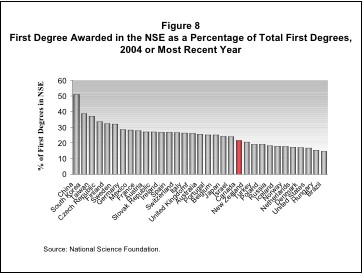
The PromoScience program provides support to non-profit and public organizations that work with young Canadians in order to build their interest in science and engineering, motivate and encourage their participation in science and engineering activities, and train teachers who are responsible for the science and math education of young Canadians. NSERC closely monitors the progress of these grants and reviews final reports to ensure impact. A selection of early outcomes from PromoScience grants is presented in Figure 9. The program is allowing organizations to expand their offerings and to engage many more young Canadians, especially girls and aboriginal youth. A potential indicator of the long-term impact of PromoScience funding can be gauged from an exit survey of NSERC Undergraduate Student Research Award recipients (see Section 2.1.2) in which 30.1% of 13,067 respondents (who are currently enrolled in an NSE bachelor's degree program) took part in science camps or fairs either in elementary school or high school.
Figure 9
Examples of PromoScience Program Impact
| Organization Supported | Impact of NSERC Funding | |
|---|---|---|
| Chuntoh Education Society | The Chuntoh Education Society is a registered charity that provides children and youth with environmental and cultural educational opportunities in a focused and positive outdoor atmosphere. |
The society has expanded its suite of cultural programs:
|
| University of Manitoba / Centre for Earth Observation Science (CEOS) | Schools on Board is an outreach program of ArcticNET hosted by CEOS. It promotes Arctic sciences in high schools across Canada. |
NSERC funding has supported the expansion of the educational and outreach potential of the program:
|
| Perimeter Institute for Theoretical Physics | Einstein Plus is a highly interactive workshop for high school physics teachers on the topic of modern physics. |
The workshop has been very successful:
|
| Tantramar Wetlands Centre | The Tantramar Wetlands Centre is a non-profit organization providing high quality science enrichment opportunities using a wetland as an outdoor classroom. |
Educational programs and participation rates have grown:
|
2.1.2 Support Students and Fellows
An overview of the "support students and fellows" program activity is presented below:
| Description | Expected Results | ||
|---|---|---|---|
| This program activity supports training of highly qualified personnel through scholarship and fellowship programs. | A supply of highly qualified Canadians with leading-edge scientific and research skills for Canadian industry, government and universities | ||
| Resources (2007-08) | Clients Supported (2007-08) | ||
| Planned Spending | $136.4M | Undergraduate Students | 4,190 |
| Actual Spending | $137.9M | Master's/Doctoral Students | 4,628 |
| Planned Human Resources | 54 | Postdoctoral Fellows | 683 |
| Actual Human Resources | 50 | ||
NSERC provides direct financial support to students from the undergraduate to postdoctoral levels through key programs such as:
- Undergraduate Student Research Awards ($19.0M): Held in university or industry laboratories, this program provides funding for an undergraduate student to spend a four-month work term in a university or industrial research environment. This program is important to help attract the best students to advanced studies and careers in research.
- Postgraduate Scholarships ($93.6M): At the master's and doctoral levels, NSERC supports students by providing an annual stipend that enables them to continue to pursue their research interests. Up to four years of support is available over the course of a candidate's graduate studies. Opportunities for study at institutions in Canada and abroad as well as at Canadian industrial laboratories are available. Canada Graduate Scholarships (tenable only at Canadian universities) are awarded to the most outstanding candidates.
- Postdoctoral and Industrial R&D Fellowships ($18.9M): These two-year awards support researchers who have completed their Ph.D., and provides them with funds to continue their programs of research. The awards may be held at any academic institution through a Postdoctoral Fellowship, or at a Canadian company that conducts research through an Industrial R&D Fellowship.
The remaining funds under the program activity were used for the administration of the programs above.
NSERC also funds students and fellows through support provided by an NSERC-funded professor from his or her NSERC grant. More students and fellows are funded through this "indirect" route (17,000) than through the direct scholarships or fellowship awards (9,501) presented under this program activity. General macro-level economic outcomes for university graduates in the natural sciences and engineering provide ample evidence of the positive outcomes for NSERC-funded students, both directly and indirectly supported.
NSERC conducts several surveys of its scholarship and fellowship winners and is able to assess performance against expected results. In addition, Statistics Canada collects labour market information that provides ample evidence of the successful career outcomes of NSE graduates. The following sections present data from both sources for this program activity.
Undergraduate Student Research Awards:
NSERC provides four-month positions for undergraduate students in the natural sciences and engineering through our Undergraduate Student Research Awards (USRA) program (note: NSERC-funded professors also support undergraduate students through their NSERC research grants). NSERC's current annual investment of $19 million in this program brings this experience to nearly 4,200 students every year. Providing these students with valuable experience in a university or industrial laboratory encourages them to undertake graduate studies. This is an important indicator of the impact of the program. Figure 10 provides outcome data from six surveys conducted with USRA recipients involving 13,067 respondents (63.4% response rate). Overall, the program is offering students a high quality training experience and is encouraging a significant number to pursue postgraduate studies in the NSE.
Figure 10
Performance Related to NSERC Undergraduate Student Research Awards (USRA)
| Short-term Outcomes |
|
| Longer-term Outcomes |
|
NSERC Postgraduate Scholarships:
NSERC provides scholarship support for Canadians to pursue master's or doctoral degrees in the natural sciences and engineering. These programs support more than 4,600 students annually at a cost of $94 million per year.
The career status of former NSERC-funded master's and doctoral students and the degree to which NSERC funding affects their ability to undertake or continue with their studies are important indicators of the impact of the scholarship support. Over the past thirteen years, NSERC has completed eleven surveys (three exit surveys - 1,680 respondents/68% response rate; and eight follow-up surveys nine years after the award - 1,850 respondents/49% response rate) of directly-funded master's and doctoral students. Some of the key findings related to the short and longer-term outcomes experienced by these students are highlighted in Figure 11. Virtually all of the training objectives of the program are being met and labour market outcomes for the students, early on in their careers, are very promising.
Figure 11
Performance Related to NSERC Postgraduate Scholarships
| Short-term Outcomes |
|
| Longer-term Outcomes |
|
Postdoctoral Fellowships:
After a doctoral degree, in many of the NSE fields, a significant proportion of graduates go through additional postdoctoral research training. NSERC directly funds postdoctoral fellows (PDFs) for up to two years to continue their research training. NSERC invested $15 million to support 496 Canadian PDFs in 2007-08.
The career status of former NSERC-funded postdoctoral fellows and the degree to which NSERC funding affects their ability to pursue a research career are important indicators of the impact of the postdoctoral support. Over the past eight years, NSERC has completed four surveys (573 respondents/40% response rate) of directly-funded postdoctoral fellows seven years after their award and two exit surveys (150 respondents/65% response rate) after the completion of the award. Some of the key findings from the surveys are presented in Figure 12. NSERC-funded postdoctoral fellows are actively engaged in research and experience the same positive labour market outcomes as postgraduate students.
Figure 12
Performance Related to NSERC Postdoctoral Fellowships (PDF)
| Short-term Outcomes |
|
| Longer-term Outcomes |
|
Industrial Research and Development Fellowships:
An important route for doctoral graduates to gain additional research experience is through NSERC's Industrial R&D Fellowships (IRDF) program. The program currently invests approximately $4 million per year to help place 150-200 Canadian Ph.D.s annually in industrial laboratories. This investment has contributed significantly to the number of doctoral graduates working in Canadian industrial labs. More than 20% of Canadian industrial researchers with a Ph.D. have been funded by NSERC through the IRDF program. To determine if the program is staying on track, NSERC routinely monitors the employment situation of former IRDF winners. Some key findings are presented in Figure 13.
Figure 13
Performance Related to NSERC Industrial R&D Fellowships (IRDF)
| Short-term Outcomes |
|
Economic Analysis
The highlights of a recent economic analysis of NSERC's student and fellowship support conducted by Torben Drewes, a professor of economics at Trent University, are shown below.
The social benefits produced by investments in postsecondary education in NSERC-related fields of study exceed the social costs by a significant margin. The essential question asked is whether NSERC's annual expenditures on student support represent a good investment of public funds. The answer to that question depends on a critical, but unknown, piece of information: how many more students undertake postgraduate education because of that support? In the absence of that information, the analysis inflates the annual flow of pre-tax incomes (which represent the productivity profiles of individuals with different levels of education) to incorporate the external social benefits of enhanced productivity of other workers, lower crime rates, and so on. Social costs in the form of instructional expenditures are factored in. The differences between the social benefits and costs between bachelor's and master's graduates, and between master's and Ph.D. graduates represent the annual social benefit flows from investments in master's and in Ph.D. programs, respectively. These benefits are then discounted at a rate of 2.5% to determine the capitalized, or present, values. It is then possible to estimate the total social benefit produced at different assumptions about the number of students induced by NSERC funding to continue their studies.
The analysis indicate that if only 1,000 master's and 1,000 Ph.D. students were influenced in enrolling in graduate programs because of NSERC funding, NSERC scholarship programs will more than pay for themselves in net social benefits produced since NSERC funds more than 14,000 master's/doctoral students. It would seem reasonable to assume that NSERC- induced participation is at least as high as that.
Labour Market Outcomes
Since 1978, NSERC has supported the training of more than 75,000 master's and doctoral students in the NSE. These graduates are major contributors to knowledge creation and technology transfer in Canada. Surveys of NSERC-funded students early in their careers indicate extremely positive employment outcomes.
These results are not surprising given the strong demand for natural science and engineering graduates. Unemployment levels for persons seeking work in natural science or engineering occupations are considerably below national levels (see Figure 14) and annual salaries for this group are nearly 32% greater than the national average (see Figure 15).
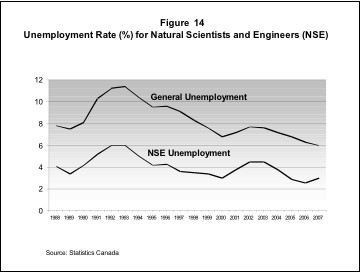
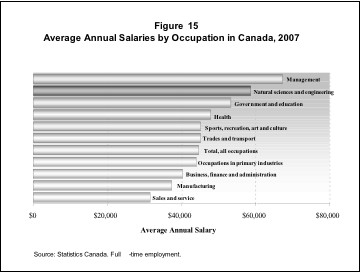
NSERC-funded graduates are now part of a growing natural science and engineering labour force of more than 1,000,000 people (see Figure 16). As the knowledge economy continues to grow in Canada, employers will hire increasing numbers of NSE graduates, as they have in the past (see Figure 17). As also shown in Figure 17, natural science and engineering positions have been the fastest growing occupational group over the past 20 years.

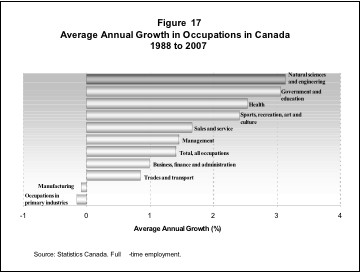
2.1.3 Attract and Retain Faculty
An overview of the "attract and retain" program activity is presented below:
| Description | Expected Results | ||
|---|---|---|---|
| This program activity aims to attract and retain faculty at Canadian post-secondary institutions. It includes a number of Chairs programs that strengthen research excellence and teaching at Canadian universities by providing support for faculty in specific fields. | Enhanced research capacity in science and engineering. | ||
| Resources (2007-08) | Clients Supported (2007-08) | ||
| Planned Spending | $167.8M | Professors | 1,062 |
| Actual Spending | $148.0M | Undergraduate Students | 279 |
| Planned Human Resources | 23 | Master's/Doctoral Students | 454 |
| Actual Human Resources | 21 | Postdoctoral Fellows | 239 |
Key programs under this program activity include:
- Canada Research Chairs ($115.9M): This Tri-Council (NSERC, CIHR and SSHRC) program provides financial support for up to 2,000 professors across Canada, including 846 positions in 2007-08 within the NSE. The key objective of this program is to enable Canadian universities to achieve the highest levels of research excellence and to become world-class research centres in the global knowledge-based economy.
- Industrial Research Chairs (IRC), Other Chairs and Faculty Support Programs ($27.7M): The IRC program helps universities build the critical mass of expertise and long-term relationships with corporate partners in areas of research that are of importance to industry. Industrial Research Chairs can also enhance the ability of universities to recruit senior-level
researchers and research leaders from industry or other sectors.
Support of university faculty in targeted areas such as Northern Research, Management of Technological Change, Fuel Cells, Design Engineering, and Women in Science and Engineering helps address specific needs in particular disciplines. - Prizes ($2.1M): NSERC prizes recognize outstanding individual Canadian researchers, research teams and students. They enhance the career development of outstanding and highly promising scientists and engineers and distinguish the sustained excellence of faculty members at Canadian universities. They also publicly recognize lasting partnerships in R&D between university and industry and celebrate young Canadian entrepreneurs.
The remaining funds under the program activity were used for administration of the programs above.
By far, the largest program of this program activity is the Canada Research Chairs program. The first awards were made in 2000-01 and by 2007-08 the program supported nearly 850 positions in the natural sciences and engineering in universities, and almost 1,000 in other disciplines. A fifth year evaluation of the program was recently completed (the evaluation was for all disciplines and a copy of the report can be found at: http://www.chairs.gc.ca/web/about/publications_e.asp.
The Canada Research Chairs program has helped to create a research environment that is conducive to the long-term retention and attraction of top researchers. A significant number of Chairholders has been attracted from outside Canada and many top Canadian scientists have stayed in the country as a result of Chair support. Figure 18 presents the distribution of Chair awards in the natural sciences and engineering since the program's inception.
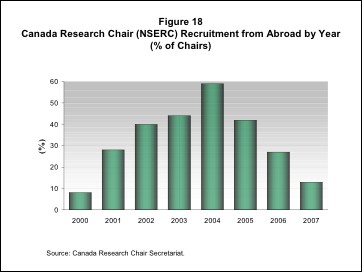
Industrial Research Chairs
An evaluation of NSERC's Industrial Research Chairs (IRC) program was conducted in 2006-07. Key findings from the evaluation indicate a strong impact on Chairholders and universities in terms of enhanced research capacity and building critical mass. Partners are also benefitting immediately through more unfettered access to longer-term research and specialized expertise with opportunities to share costs and risks associated with conducting longer-term research. More detailed evaluation findings are as follows:
- The majority of partner respondents reported the strongest impacts with respect to increased access to specialized expertise and research results. These impacts are consistent with the partners' expectations of the IRC program. Ongoing access to the Chairholder's expertise was considered to benefit the partner organizations by facilitating the transfer of knowledge/technology with respect to cutting edge research, and potential new processes, products and methodologies for exploring research problems. Moreover, the Chair, through its network of collaborations, provides the partner organization with access to expertise beyond the Chair.
- Survey evidence shows that IRC research is being used by industry, most commonly to improve or develop processes and products (see Figure 19). Additionally, other receptor organizations typically use research results. A comparison of earlier and more recent Chairs revealed that, with the exception of prototype or pilot development, a greater percentage of the earlier Chairs showed evidence of transfer of knowledge/technology (e.g. increases in the number of patents issued, numbers of technologies licensed, and improved and new processes and products) indicating that commercialization of results is being realized over time.
- The IRC program plays a strong role in strengthening existing partnerships and in creating new partnerships between industrial partners and universities. Sixty-seven (67) percent of industrial partner respondents reported that the existing partnerships with universities have been strengthened as a result of the IRC program. Forty-two (42) percent of all partner respondents reported that their organization had formed new partnerships with university researchers and 31 percent reported that they had formed new partnerships with other organizations as a result of the IRC.
- The IRC program was reported to contribute significantly to the achievement of critical mass and helped to bridge gaps in existing programs or developed niche areas (e.g. automotive sector, environmental science, construction engineering and management). The building of critical mass in industrially relevant areas was linked to a number of the program's features and benefits such as its leveraging effect, its effectiveness as a tool to recruit and retain faculty (through salary support and increased prestige), and its ability to attract HQP.
- About one-third of industrial partner respondents indicated that they have hired HQP from the program. Survey results indicated that more than two-thirds of HQP who obtain employment are employed by industrial partners and industry upon completion of their involvement with the IRC.
- All lines of evidence supported the assertion that the Chair program contributed substantially to the Chairholder's research capacity in terms of increased size of research team, increased ability to attract more qualified personnel, enhanced reputation within the research community, and increased visibility of the research program with industry in general. There was also strong consensus that research was strongly impacted by the IRC program in terms of increased productivity and in terms of an expansion of the research scope.
- According to case study evidence, collaborations with industry also benefit the Chairs and their research in the following ways: by helping them to keep informed of industrial needs and context; by helping to identify fundamental, long-term research objectives; by providing data for future research and development; by providing a "testing-ground" for tools and knowledge; and by providing feedback on the results of the research.
Figure 19
Knowledge and Technology Transfer (Partner Survey) - IRC Program
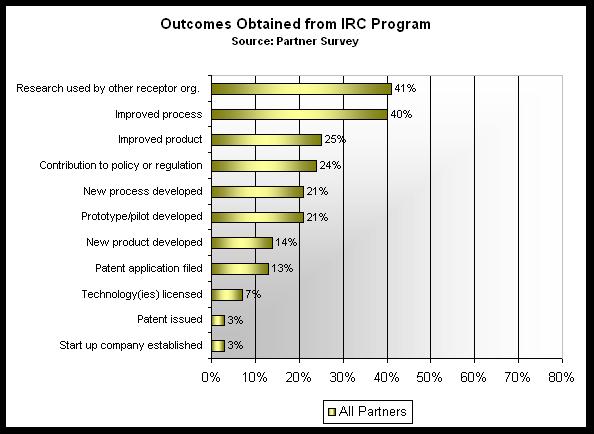
Attraction/Retention of Faculty
Other evidence of outcomes related to the attraction/retention of faculty comes from NSERC corporate data. Although NSERC does not collect the citizenship history of its applicants, a reasonable guess at citizenship can be made through the education history of applicants. Figure 20 presents the number of new applicants to NSERC's largest program, the Discovery Grants program, who received both their bachelor's and Ph.D. degrees outside the country (this program is a good proxy for an overall evaluation of the "attraction" activity since the vast majority of new professors in the natural sciences and engineering apply to the program). As the figure indicates, Canadian universities continue to attract hundreds of foreign educated personnel every year to become professors. More than 30% of the large number of first-time NSERC applicants are foreign educated. Recent investment by the government in university research has created an attractive environment to conduct research and seems to have attracted the attention of highly trained people from other countries.
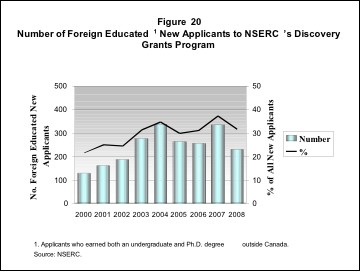
NSERC also tracks the reasons grantees provide when they terminate their awards before the end date. As shown in Figure 21, only a small number of professors receiving NSERC support listed "leaving the country" as their reason for terminating their award over the past eight years. The number of NSERC-funded professors leaving the country is an extremely small percentage of the nearly 12,000 professors receiving NSERC support.
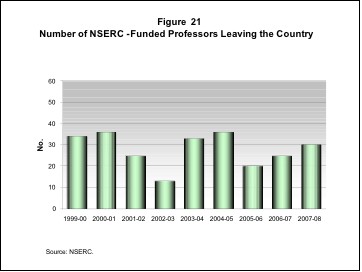
The strong federal support of the granting councils and the Canada Foundation for Innovation (CFI) since 1997-98 (see Figure 4), and the increased support for research from provincial governments have dramatically improved the research environment on university campuses across the country. The success witnessed above in the attraction and retention of faculty cannot be attributed to any one program and has resulted from system-wide investments.
To recognize the important achievements of Canadian research scientists and engineers, and, in the process, to help retain faculty in Canada, NSERC awards significant research prizes to individuals and teams. The 2007-08 winner of NSERC's Gerhard Herzberg Canada Gold Medal for Science and Engineering is highlighted below.
A chemist at the University of Toronto has claimed the Gerhard Herzberg Canada Gold Medal for Science and Engineering, Canada’s most prestigious science prize. Named for Canadian Nobel laureate Gerhard Herzberg, the annual prize guarantees the winner $1 million in research funding over the next five years.
Polanyi’s natural curiosity and approach to science have led to a number of major advances in chemistry over the years. Most notably, he helped pioneer the development of a new field known as reaction dynamics. This method of study takes chemical reactions down to the molecular level in an effort to understand what happens during a reaction. His contributions to this field earned him a share of the 1986 Nobel Prize for Chemistry.
In addition to the Nobel, Polanyi has been awarded numerous scientific prizes and honorary degrees from universities around the world. He is a Companion of the Order of Canada and a Fellow of the Royal Societies of Canada, London and Edinburgh.
Polanyi’s distinguished career touches on more than just pure science. He has published numerous articles on science policy, on the control of armaments and the impact of science on society. He was the co-founder and first Chair of the Canadian Pugwash Group, part of an international movement dedicated to understanding the social impact of science and preventing its misuse.
2.2 High Quality Canadian-Based Competitive Research in the NSE
Basic research provides the foundation for all scientific and technological advances, and also trains the people who can generate new knowledge in Canada and understand new knowledge generated around the world.
An overview of the "fund basic research" program activity is presented below:
| Description | Expected Results | ||
|---|---|---|---|
| This program activity invests in discovery through grants focusing on basic research activities. Basic research provides the foundation for advances in all disciplines within the NSE, and also trains people who can generate new knowledge in Canada. | The discovery, innovation and training capability of university researchers in the NSE is enhanced. | ||
| Resources (2007-08) | Clients Supported (2007-08) | ||
| Planned Spending | $403.6M | Professors | 10,685 |
| Actual Spending | $454.3M | Undergraduate Students | 3,800 |
| Planned Human Resources | 127 | Master's/Doctoral Students | 6,678 |
| Actual Human Resources | 143 | Postdoctoral Fellows | 748 |
Key programs under this program activity include:
- Discovery Grants ($333.4M): This program is the mainstay of support for university-based research. The program provides funding for ongoing programs of research. Researchers are free to work in the mode most appropriate for the research area and they may pursue new research interests provided they are within NSERC's mandate. To be funded, they must demonstrate both research excellence and high productivity, and contributions to the training of HQP.
- Research Tools and Instruments Grants (RTI) ($40.8M): CFI funding enhances the laboratory setting by funding major equipment and infrastructure purchases. RTI grants enable professors to purchase the smaller pieces of laboratory equipment necessary to conduct world-class research. This critical source of funding ensures researchers have access to the modern research tools required to ensure the maximum return on other investments in research, such as Discovery Grants.
- Major Resources Support (MRS) ($35.2M): The MRS program supports researchers' access to major regional or national research facilities by assisting these facilities to remain in a state of readiness for researchers to use. This program is the vehicle for NSERC investments in facilities such as the Canadian Light Source synchrotron in Saskatoon and the Sudbury Neutrino Observatory.
- Special Research Opportunity (SRO) Grants ($10.6M): These grants enable researchers to seize new and emerging research opportunities in a timely fashion and develop new collaborations necessary to respond to national and international opportunities.
Other programs under this program activity include funding for the Government of Canada's Program for the International Polar Year ($12.1M), Research Capacity Development in Small Universities ($2.2M), and General Support ($1.3M) and funding for the administration of all of the above programs.
Section 2.1.2 provided a broad perspective on student outcomes for undergraduate and postgraduate students in the natural sciences and engineering. For the remainder of this section, highlights of performance measures related to research funding will be presented. The outcomes presented also capture performance from most of NSERC's other grants programs. As mentioned, it is very difficult to disentangle broad performance measures by NSERC program.
International Review
In 2007-08, a special International Review of the Discovery Grants program was conducted by a prestigious committee of scientists and engineers. The committee came to the following conclusions (the full report can be found at http://www.nserc.gc.ca/about/rep_sur_e.asp).
- The relatively high success rates of Discovery Grants program applications is not incompatible with, and in fact encourages, a high degree of research excellence across a broad range of fields.
- The best researchers are able to use the support of a Discovery Grant as a base to lever an internationally competitive level of funding from other sources.
- The broad base of Discovery Grants program funding sustains an important level of research capability and student training across the NSE disciplines and throughout Canada, and thus contributes significantly to meeting the nation's needs for research results and highly-qualified people.
- The Discovery Grants program is therefore an exceptionally productive investment and thus deserves additional funding to ensure that the value of its grants keeps pace with the growing opportunity.
What follows are some indicators demonstrating the excellence and productivity of Canadian researchers.
Discovery Accelerator Supplements
In 2007-08, NSERC launched a new initiative, targeted accelerator supplements, to provide substantial and timely additional resources to a small group of outstanding researchers, the majority working in the three S&T Strategy priority areas to accelerate progress and maximize the impact of their program. Through peer review, NSERC identified 41 top researchers in the three S&T Strategy priority areas whose research efforts could be dramatically accelerated by an infusion of $40K per year over three years.
Knowledge Advantage Indicators
One of the first tangible outcomes of an investment in university R&D is a publication in a scientific or engineering journal. The worldwide culture of university research places a great deal of importance on publishing new discoveries and advances in widely-circulated journals. Investment in this very public forum gives the country's researchers access to the latest international research and the ability to build on this research. Since the vast majority of Canada's scientific and engineering publications are produced by university researchers, publications are a good indicator of the immediate outcome from NSERC research funding and can be used to benchmark our performance against the rest of the world.
In a previous comprehensive study of publications it was determined that NSERC-funded professors are by far the major contributors to Canada's science and engineering publication output. For this reason, the review of national output as follows can be correlated to NSERC-funding.
Canada is among an elite group of countries publishing a significant number of articles in science and engineering journals. Canadian researchers (all sectors) in the natural sciences and engineering (NSE) have increased their annual production of publications from roughly 20,000 per year to current averages of approximately 25,000 publications per year, as shown in Figure 22. Overall, Canada's world share of NSE papers stood at 4.4% in 2006. Canada's performance in NSE article production versus many of our major competitors has been similar, as most industrialized countries lose publication share to countries such as China, South Korea and Spain. It appears that the upswing of Canada's publications and world share of publications are the first signs of the impact of the additional investments in university research over the past several years.
World article production in the NSE has averaged roughly 600,000 articles per year, with a significant increase in 2003 as more journals were included in the dataset. The U.S. dominates publication production with nearly one-third of NSE articles in any given year. Canada ranked in 7th position in 2006 improving from its 9th place showing in 2001 to 2003. Canada's world rankings by discipline ranged from 6th spot for biology and earth and space sciences to 12th position in chemistry and physics.
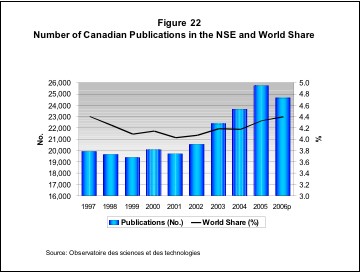
Similar to common rating systems, in which a higher score indicates more viewers, listeners or readers, citations are a measure of the potential use of a researcher's work by fellow researchers. If a researcher's work is being referenced or cited more often by his/her peers, then there may be more intrinsic value to the work. Based on the number of citations received by papers over the three years following the publication year, a standardized measure called the Average Relative Citation Factor (ARC) is then calculated for each country and field and normalized to 1.0. An ARC value above 1.0 for a country and field means that, on average, the country's publications in that field are cited more often than the world average. An ARC value below 1.0 would mean that a country's publications in a field are not cited as often as the world average.
Figure 23 presents the ARC values for countries publishing more than 5,000 articles in the NSE in 2006. Canada's ARC in the NSE ranks 7th and is in a tight grouping with the G7, and only significantly behind the top four countries (Switzerland, Netherlands, U.S. and Germany).
Publishing in the top journals in a scientific field is a potential indicator of excellence and a complementary indicator to the average relative impact factor. Science and Nature are two journals in the natural sciences that are very selective, highly influential and widely read. Canadian researchers were authors on more than 6% of articles appearing in Science and Nature in 2007 while producing 4.4% of total publications.
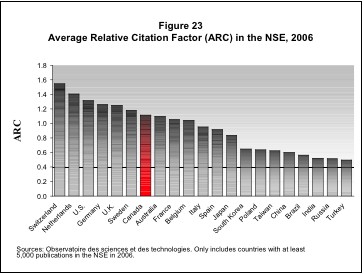
Figure 24 highlights, for the most recent time period: 2002-2006, the ratio of a country's world share of citations in a particular subfield to the country's world share of publications in that subfield. For example, the percentage of citations to Canadian space science publications exceeded Canada's world production of space science papers by 57% in 2002-2006. Canada is only one of three countries to have a positive relative citation impact for all subfields of the NSE.
Indicators of productivity as they relate to scientific publication production can also be useful. One indicator is a measure of a country's output of NSE publications per capita population. Figure 25 presents the 2006 per capita output per one million inhabitants for those countries producing a significant number of articles (the cut-off chosen was at least 5,000 articles published in 2006). Using this criterion, Switzerland has the highest per capita output while Canada ranks in 4th position, and ahead of some significant players such as the U.K., France, Germany, United States, Japan and Italy.
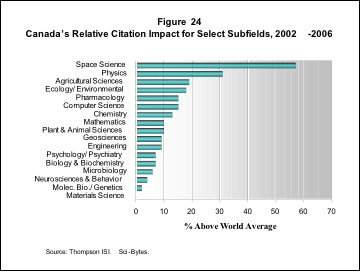
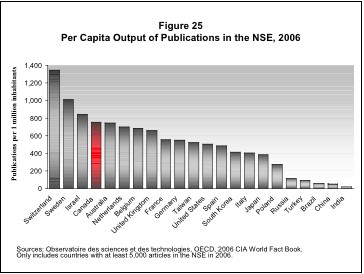
The published research findings funded by NSERC are recognized as significant contributions to world science and engineering. A sample of significant research findings funded by NSERC in the areas of the environment, energy, information and communication technologies, and health are highlighted in Figure 26.
Figure 26
Sample of Important Discoveries of 2007-08 Funded by NSERC
| What | Where | Who | How | |
| Environment | Island nations' fisheries unsustainable | Simon Fraser University | Dr. Isabelle C�t� | Dr. C�t� and colleagues studied 49 island countries and found fish catches are, on average, 64% above sustainable levels. In nine of the countries, fisheries have already collapsed. |
| Results of 24-year study in the Arctic | Queen's University and University of Alberta | Dr. Marianne Douglas and Dr. John Smol | Drs. Douglas and Smol have been monitoring 40 shallow ponds in the Arctic for the last 24 years. Their studies show that climate change is responsible for alarmingly low water levels. Some lakes which had been around for thousands of years have already evaporated. | |
| Fish populations affected by "The Pill" | University of New Brunswick | Dr. Karen Kidd | Dr. Kidd was part of a seven-year Fisheries and Oceans study which found minnow populations in an experimental lake began to collapse after prolonged exposure to small amounts of synthetic estrogen. Male fish began producing egg proteins and early stage eggs were found in the testes of some fish. | |
| Energy | Breakthrough in hydrogen storage | University of New Brunswick | Dr. Sean McGrady | Dr. McGrady's team successfully condensed hydrogen gas into a usable solid under mild conditions. At the moment, hydrogen gas is typically stored under pressure in large, metal cylinders, which are heavy and expensive to transport. Since they're under pressure, they also pose a safety hazard. |
Figure 26
Sample of Important Discoveries of 2007-08 Funded by NSERC (cont'd)
| What | Where | Who | How | |
|---|---|---|---|---|
| Information and Communications | Sudoku has practical mathematical applications | Queen's University | Dr. Ram Murty and Dr. Agnes Herzberg | Analyzed the game from a math perspective. Using graph theory, the researchers found the theory behind Sudoku could be used to optimize communications networks and airline schedules. |
| Solar activity responsible for dropped cellphone calls | Queen's University | Dr. David Thomson | While investigating communications satellite failures in the 1990s, Dr. Thomson discovered that satellites and cell phones responded similarly to changes in solar gravity modes. He continued to study this phenomenon as it related to dropped calls. By comparing solar flare activity with records of dropped cell phone calls, he was able to show a definite correlation. His next step is figuring out how this occurs. | |
| Wireless device to record radiation levels | Carleton University | Dr. Atif Shamim and Dr. Muhammad Arsalan | Invented a small, disposable wireless device to monitor the amount of radiation in a patient's body. The invention won a $6,000 prize at the Canadian Microelectronics Corporation TEXPO in 2007. | |
| Health | Developed virtual scoliosis surgical software | �cole Polytechnique de Montr�al | Dr. Carl-�ric Aubin | Dr. Aubin's pre-operative surgical simulation tool will allow surgeons to test the effects of scoliosis operations before they operate and plan which implants to use in order to obtain optimal correction. |
| Better radiation treatment | University of Windsor | Dr. Chitra Rangan | Dr. Rangan uses mathematical algorithms so a computer can pinpoint a tumour in a patient's body scan and target the radiation without damaging other organs. | |
| Trans fat-free shortening | University of Guelph | Dr. Alex Marangoni | Developed a trans fat-free shortening, known as CoaVel, which is now baked in eight different cookies by Tasty Selections and sold to Canadian hotels. | |
| Weightlifting makes old muscles new again | McMaster University | Dr. Mark Tarnopolsky | Found resistance exercise for people 65 and older can actually reverse the effects of aging on skeletal muscles. |
Awards and prizes are another measure of excellence in the research community. NSERC collects and updates data on 191 international awards and prizes annually. Over the past 10 years. NSERC-funded professors have received more than 150 of the awards and prizes included in the analysis. One example of a prestigious prize won by an NSERC-funded researcher is shown below.
$10 million grant from King Abdullah University of Science and Technology, KAUST, in Saudi Arabia
Dr. Ted Sargent, a professor of electrical and computer engineering and Canada Research Chair in Nanotechnology will receive a $10 million grant from KAUST, an international graduate-level research university set to open in September 2009.
The competition was open to all internationally recognized scientists and engineers having an outstanding record of prior accomplishments and a very high level of originality and productivity. Dr. Sargent, one of the most celebrated scientists of his generation, was the only person at a Canadian university to receive a grant.
Working at the University of Toronto, Dr. Sargent has developed nanotechnology that uses the infrared rays of the sun to provide power for virtually everything that now uses electricity. He has also brought nanotechnology to a wide audience with his popular book, The Dance of Molecules.
Knowledge dissemination occurs through virtually every NSERC program. The new knowledge created by NSERC-funded university professors is often used by researchers in Canadian industry and government laboratories. One of the first indications of this dissemination to users is through collaborative publications. Figure 27 indicates that over 800 university-government publications and, on average, 400 university-industry publications are produced annually. This trend has been fairly steady over the past decade, although the downturn in Canadian industrial R&D in recent years has had an impact on the number of university-industry collaborative papers.
In 2007, NSERC conducted a survey of NSERC-funded professors (2,590 respondents/45% response rate) to gauge their activities in terms of knowledge dissemination to users (industry and government) and knowledge transfer/commercialization. Figure 28 highlights the percentage of the survey respondents who carried out research with industry or government partners in the last five years, or involved users in helping set the direction of their research programs. A large percentage of the respondents participated in this type of collaborative R&D, ensuring quick knowledge dissemination to users.
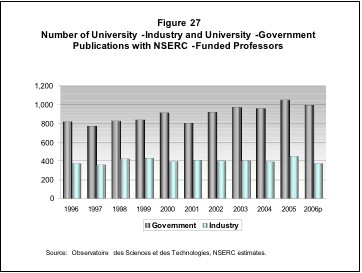
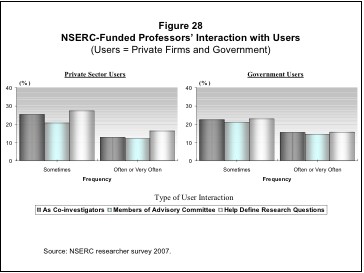
Also from the survey, Figure 29 presents the frequency with which NSERC-funded professors took user needs into consideration when planning their research projects, and the frequency with which NSERC-funded professors performed services for private firms related to their research. To some degree, the majority of professors took into account the needs of users in planning their projects. It must be noted that not all research, especially basic research, has clearly-defined users or applications. Although the majority of respondents engage in a variety of knowledge-dissemination efforts, a minority do not. Improving knowledge dissemination to potential users will be an important goal for NSERC and future surveys will monitor the situation. From the previous knowledge transfer survey (conducted in 2000), respondents mentioned many impediments to knowledge transfer to users. Nearly half of the respondents mentioned lack of expertise of users, lack of firms in the region, lack of academic rewards for dissemination and the pressure to publish as various obstacles to knowledge dissemination.
| Dissemination Activity by NSERC-funded Professors | Never or rarely (%) | Sometimes (%) | Often or very often (%) |
|---|---|---|---|
| Dedicated time for disseminating research results | 14.5 | 23.8 | 61.7 |
| Identified what part of their research results they want to disseminate to user | 27.0 | 25.2 | 47.8 |
| Identified individuals or organizations that could benefit by applying the research results | 29.4 | 31.1 | 39.6 |
| Dedicated financial resources for disseminating research results | 35.0 | 26.5 | 38.5 |
| Dissemination Activity to Private Firms by NSERC-funded Professors | Never or rarely (%) | Sometimes (%) | Often or very often (%) |
| Sent my research results directly | 49.4 | 29.8 | 20.9 |
| Sent technical reports | 50.8 | 28.4 | 20.8 |
| Gave presentations in a technical seminar organized by the firm | 53.0 | 27.9 | 19.0 |
| Presented my research results to private firms who could make direct use of them | 55.0 | 27.2 | 17.8 |
Source: NSERC Researcher Survey 2007
Recent Evaluations
An evaluation of NSERC's Research Tools and Instruments (RTI), and Major Facilities Access Grants (currently called the Major Resources Support (MRS) program) programs was conducted in 2006-07. Some of the major findings from the evaluation are presented below:
- RTI funding leads to more, faster and more in-depth research as well as better trained HQP. These impacts were felt across the spectrum of disciplines, in all regions and in large and small institutions. Small institutions tended to report benefitting more from RTI funding than larger institutions - as long as they were able to secure such funding since data have shown that the probability of funding was less for small institutions than for medium-sized and large institutions. These observations support the notion that the RTI program is achieving its objectives to enhance the discovery, innovation and training capability of university researchers.
- Three key messages from this evaluation study were:
- a significant proportion of the existing equipment infrastructure will require replacement over the coming five years - between one quarter and one third of the value of existing equipment is at play;
- about 20% of existing equipment will require major maintenance over the coming five years; and
- it is difficult for researchers to find funding for small equipment.
- Due to the amount and nature of the equipment funding, there is currently little overlap between NSERC's RTI program and Canada Foundation for Innovation (CFI) grants. In fact, constraints to usage of CFI (large-scale, state-of-the-art projects within university strategic priorities) make unlikely a dramatic overlap in financial support with RTI/MFA/MRS projects. The current MRS program complements CFI funding on several projects (e.g., Canadian Light Source) by providing the necessary operating and research support to fully utilize the facilities.
- The key impacts of the MFA (now called MRS) program were identified as better use of the facilities, increased collaboration among researchers and improved international competitiveness of Canadian researchers. Effects of a grant appear more intense for MFA projects than for RTI projects - be they the positive effects of obtaining a grant or the negative effects of not obtaining one. Increased collaboration among researchers and organizations as well as attraction and retention of faculty are much more prominent effects for MFA than RTI.
2.2.2 Fund Research In Strategic Areas
An overview of the "fund research in strategic areas" program activity is presented below:
| Description | Expected Results |
|---|---|
| This program activity funds project research of national importance and in emerging areas that are of potential significance to Canada. By creating linkages between university, industry and government, and addressing areas of strategic importance to Canada, this funding ensures Canadians reap the benefits of their investments in research. | Research and training in targeted and emerging areas of national importance is accelerated. |
| Resources (2007-08) | Clients Supported (2007-08) | ||
|---|---|---|---|
| Planned Spending | $57.7M | Professors | 1,446 |
| Actual Spending | $75.4M | Undergraduate Students | 434 |
| Planned Human Resources | 28 | Master's/Doctoral Students | 1,091 |
| Actual Human Resources | 33 | Postdoctoral Fellows | 263 |
The key program under this program activity is:
- Strategic Project Grants ($67.0M): This program accelerates research and training in targeted and emerging areas of national importance. The research is early-stage with the potential to lead to breakthrough discoveries. The program target areas coincide extremely closely to the government's current priority areas of the environment, energy, information and communications technologies, manufacturing, automotive applications, forestry, fisheries, and health.
Other programs under this program activity include funding for the Collaborative Health Research Projects ($3.3M), Innovation Platforms ($1.1M) and funding for the administration of all of the above programs.
In 2007-08, a total of $25.9M was leveraged from partners on Strategic Project grants versus NSERC's funding of $67M. Given the pre-competitive nature of the Strategic Project grants, the resulting leverage ratio of 39% shows good partner participation.
In 2004, a five-year follow-up of NSERC's Strategic Project grants was undertaken. Interviews were conducted with a total of 229 Strategic Project grant recipients (66% response rate) and 127 partners (67% response rate) from either industry or government. The margins of error for the two samples are +5 percentage points for the university researcher sample and +8 percentage points for the industry sample, with a 95% confidence interval. Some of the highlights from the survey are presented below:
- Almost all respondents indicated that their Strategic Project grant experience had been worthwhile (i.e., 99.6% of university researchers, 95.7% and 100% of industry and public sector partners respectively).
- In assessing post-award collaboration, a total of 163 researchers (i.e., 71%) indicated that they had continued to collaborate with their strategic project grant partners. This represents 144 researchers (i.e., 64%) who continued working with the same partner(s) in the same area as their strategic project grant, and an additional 19 researchers (i.e., 8%) who indicated that they continued to work with their partners, but on different projects.
- Figure 30 presents the benefits industry and government partners realized from their participation on the Strategic Project grant.
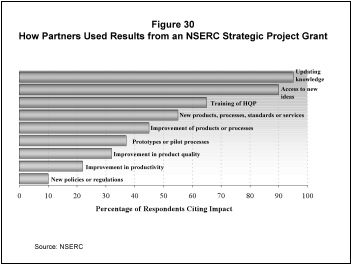
Overall, the Strategic Projects program is achieving its main objectives and is resulting in significant HQP production and knowledge transfer to the user community.
The NSERC Strategic Partnerships Programs are designed to focus on priorities (NSERC Strategic Target Areas) and so provide an excellent framework to implement the S&T Strategy. In 2007-08, NSERC's commitment to the S&T Strategy through the Strategic Partnerships program included:
- Re-scoping and repositioning the descriptions for NSERC's three target areas (Advanced Communications and Management of Information; Healthy Environment and Ecosystems; and Sustainable Energy Systems) to align more directly with the S&T Strategy priority areas.
- Increased funding in the 2007 competition ($4.4M/yr for 3 years) to support 30 additional projects in the priority areas of Environment, Energy and ICT. A total of 101 additional researchers and 59 partners are involved in these projects and we anticipate more than 150 students will be trained.
- Launched a special supplemental competition to rapidly increase research and partnerships in the three target areas (Advanced Communications and Management of Information; Healthy Environment and Ecosystems; and Sustainable Energy Systems) aligned with the S&T Strategy priority areas. A total of 160 awards were made at an annual investment of $15M per year over the next two years (see an example of one of the funded grants below).
- Six additional Strategic Networks (public-private research partnerships) in the three priority areas of the environment, ICT and energy/natural resources.
- To better align with S&T Strategy, the Strategic Network Grants Program has been redesigned to enhance international research and training and accelerate the transfer of knowledge and new technology into use in the Canadian economy.
Title: New generation intelligent user interface for effective and ubiquitous and pervasive communication.
Applicant: Zhang, Wenjun (Chris) (Mechanical Engineering, U. of Saskatchewan)
Co-applicants: Schneider, Barry B (Psychology, Ottawa); Gutwin, Carl (Computer Science, Saskatchewan); Shi, Yang (Mechanical Engineering, Saskatchewan).
Supporting Organization(s): Immersion Canada; MPB Technologies Inc.
Summary:
The goal of this project is to develop a new generation of intelligent interface for human-computer and human-machine communications. While the main tasks of the project are to be accomplished by computer scientists and mechanical engineers, a thorough understanding of human behaviour is needed to provide the computer/machine with the appropriate tools to understand the human. The
addition of a psychologist to the research team will allow them to correctly address the human behaviour issue, and to provide students with very valuable inter-disciplinary training.
2.3 Productive Use of New Knowledge in the NSE
Wealth is created when Canadians add value in producing goods and services that are sold in world markets and knowledge is the modern basis for adding value. NSERC aims to maximize the value of public investments in research for the benefit of all Canadians by promoting research-based innovation, university-industry partnerships, technology transfer activities and the training of people with the required scientific and business skill sets to create wealth from new discoveries in the NSE.
2.3.1 Fund University-Industry-Government Partnerships
An overview of the "fund university-industry-government partnerships" program activity is presented below:
| Description | Expected Results |
|---|---|
| This activity supports NSERC's priority of realizing the benefits of public investments in research by creating productive collaborations between university researchers and the industrial receptors who are able to create value from new discoveries. | Mutually beneficial collaborations between the private sector and researchers in universities, resulting in industrial or economic benefits to Canada. |
| Resources (2007-08) | Clients Supported (2007-08) | ||
|---|---|---|---|
| Planned Spending | $115.0M | Professors | 2,538 |
| Actual Spending | $181.8M | Undergraduate Students | 753 |
| Planned Human Resources | 79 | Master's/Doctoral Students | 1,764 |
| Actual Human Resources | 66 | Postdoctoral Fellows | 392 |
The key programs under this program activity are:
- Collaborative Research and Development Grants ($45.1M): This program gives companies operating from a Canadian base access to the unique knowledge, expertise and educational resources available at Canadian postsecondary institutions and offers opportunities for mutually beneficial collaborations that result in industrial or economic benefits to Canada. It also facilitates world-class research and ensures a strong source of well-trained graduates. Funding for the Canadian Microelectronics Corporation ($8.6M) is included under this activity.
- Networks of Centres of Excellence (NCEs) ($40.2M): The Networks of Centres of Excellence are unique partnerships among universities, industry, government and not-for-profit organizations aimed at turning Canadian research and entrepreneurial talent into economic and social benefits for all Canadians. These nationwide, multidisciplinary and multi-sectoral research partnerships connect excellent research with industrial know-how and strategic investment. They create a critical mass of research capacity by networking researchers and partners across Canada.
- Strategic Network Grants ($16.5M): This program funds large scale, complex research programs that involve multi-sectoral collaborations on a common research topic. The topic to be investigated can be of local concern, requiring a focused local network, or of regional or national importance, requiring a larger, more complex network.
- Research Partnership Agreements ($4.7M): A number of initiatives has been established through the Research Partnership Agreements signed with several federal government departments and agencies. The objective of these programs is to build strong linkages between the private sector, researchers in universities, and researchers in federal institutes.
A new program launched late in the fiscal year, Centres of Excellence for Commercialization & Research ($57.2M) and funding for the administration of the above programs rounds out the spending under this program activity.
Specific program outcomes as well as general performance measures related to knowledge and technology transfer will be presented. The general outcomes presented in this section also result from investments made in most of NSERC's other grants programs. As mentioned, it is very difficult to disentangle broad performance measures by NSERC program. Most of the expected results are part of the technology transfer process. This process can be described as the movement of ideas, tools and people from university professors and students supported by NSERC to the private and public sector. This movement leads to socio-economic benefits for Canadians as a result of NSERC research support.
The Collaborative Research and Development (CRD) program is intended to give companies operating from a Canadian base access to the special knowledge, expertise and educational resources at Canadian postsecondary institutions and to offer opportunities for mutually beneficial collaborations that result in industrial or economic benefits to Canada. Bringing university professors and Canadian firms together is one of the first methods of stimulating technology transfer. These industrial partners also contribute financially to these university research projects. Because of the socio-economic impacts of university research, NSERC views any additional investment in university research as having a positive impact on the Canadian economy. A comparison of NSERC funding to industry contributions for the CRD program is presented in Figure 31. Over the past decade, industrial contributions to the CRD program have outpaced NSERC's investment by over 50%, demonstrating the value Canadian industries place on university R&D and the training of students.
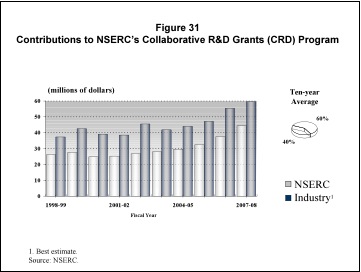
NSERC tracks the outcomes of its Collaborative Research and Development (CRD) program by following-up with researchers and partners. Results from the latest review of reports (276 CRD reports that were submitted in the fiscal years 2004/2005 and 2005/2006) conducted in 2007 are described below:
- Out of 276 reports, 49% of the projects reported contribution to new products or processes and 67% of projects reported contribution to improved products or processes.
- There were 18 new licenses generated and 103 patents had been filed. Twenty four of those had been reviewed at the time reports were received. Start-up companies were created for 13 projects.
- There were 2,531 professionals trained as a result of CRD funding. About 50% of the total professionals trained were either undergraduates (26%) or masters' students (25%). Ph.D.s trained represented 17% of the total.
- There are very close interactions between partners and highly qualified personnel (HQP) with 70% of projects reporting that HQPs presented results to partners and 68% discussed projects directly with partners.
- CRD reports required an overall ranking to assess the extent to which overall objectives of the program were achieved. The answers were rated on a scale of 1 to 7 where 1 meant "not at all", the midpoint indicated "somewhat" and 7 indicated "to a great extent." 74% of reports responded with scale 6 and 7 indicating that objectives and milestones were achieved to a large extent. There were no responses that indicated that objectives were "not met at all".
- There were 557 publications that were co-authored by industrial partners.
Recent Evaluation
In 2007, the third evaluation in the past ten years of the Networks of Centres of Excellence program was conducted. The evaluation report is available at http://www.nce-rce.gc.ca/pubs_e.htm. Some of the key evaluation findings are presented below:
- The evaluation supports the rationale for the continuation of the NCE Program.
- While many of the positive outcomes of the NCE Program are shared with other network-related programs, it performs better than these programs in some key areas, such as the creation of structured networks, the establishment of intersectoral partnerships, and knowledge utilization - in particular, the commercialization of research findings. Clearly, there is an undisputed place for the NCE Program.
- The NCE Program offers more opportunities to students with regard to publication and conferences, ethical debates and exposure to real-life practices. Participation in the NCE Program also leads to a better fit between the field of study and employment.
- NCE networks have been successful at bringing together researchers, public sector and private sector representatives, and NGOs to contribute to the definition of key knowledge issues, the execution of research and the translation of research findings into actionable results.
- Networking and collaboration programs double the amount of knowledge transfer activities and increase knowledge utilization significantly according to researchers. This finding is true for NCEs as well as other network programs. When compared to the average government agency, there was vastly more research finding utilization among NCE public sector partners in 2006 than in the average government agency.
What follows is a more general presentation of important performance measures related to the productive use of new knowledge. Many NSERC programs have contributed to the successes illustrated below.
Invention disclosures, patents and licences obtained
Statistics Canada conducts a survey of intellectual property (IP) commercialization in the university sector every one to two years. The key results from the first five surveys are highlighted in Figure 32. The survey data are confidential and it is therefore impossible to link the outcomes in the figure below to NSERC funding. However, from NSERC's analysis of patents and publications, it is highly likely that the majority would be attributable to NSERC funding. The sizeable increases seen over the six-year period for most of the commercialization activities presented is a positive result. Other commercialization trends are presented below.
Figure 32
Survey of University Intellectual Property Commercialization
| Commercialization Activity | 1999 | 2001 | 2003 | 2004 | 2005 |
|---|---|---|---|---|---|
| Inventions disclosed | 829 | 1,105 | 1,133 | 1,432 | 1,475 |
| Inventions protected | 509 | 682 | 597 | 629 | 744 |
| New patent applications | 616 | 932 | 1,252 | 1,264 | 1,427 |
| Patents issued | 325 | 381 | 347 | 397 | 374 |
| Total patents held | 1,826 | 2,133 | 3,047 | 3,827 | 3,953 |
| New licences | 218 | 320 | 422 | 494 | 577 |
| Total active licences | 1,109 | 1,338 | 1,756 | 2,022 | 2,216 |
| Royalties from licensing ($M) | $18.9 | $52.5 | $55.5 | $51.2 | $55.1 |
| Total spin-off companies | 454 | 680 | 876 | 968 | 1,028 |
| Source: Statistics Canada |
As shown in Figure 32, Canadian universities are seeking patent protection at an increasing rate. Another measure of this activity is the number of U.S. patents being issued to Canadian universities. As shown in Figure 33, university patent production has averaged more than 100 patents per year for the past decade. An analysis of the 1,403 patents issued to Canadian universities over the past 10 years has found that 956, or 68%, of the patents listed an NSERC-funded professor as one of the inventors. In addition, start-up companies linked to NSERC have been issued 850 U.S. patents over the past decade. As shown in Figure 34, all NSERC-related patents combined account for 5% to 8% of the institutional U.S. patents assigned to Canadian organizations every year.
From NSERC's 2007 researcher's survey, patenting activity by the 2,590 respondents was considerable. Over the past five years, 360 Canadian patents and 723 U.S. patents were issued to NSERC-funded professors. This suggests that patent activity is more prevalent than can be seen from just an analysis of patents assigned to universities (i.e., many patents are held/owned by the professor instead of the university).
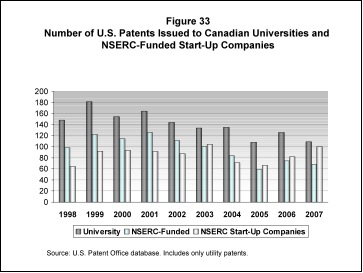
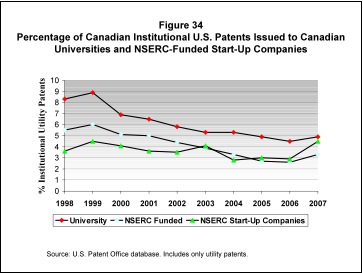
Another way university research is transferred to industry is through a licence, giving the industrial buyer the right to commercialize the research. Commercial use of the licensed technology results in royalty income to the university and typically the researcher. The amount of licensing royalty revenues is another measure of the value of university research. Figure 35 presents licensing revenues for Canadian universities. Most of these revenues can be at least partially attributed to funding from NSERC and CIHR. The trend in revenue growth has generally been positive over the decade. Examples of licences based on NSERC-funded research are presented in Figure 36.
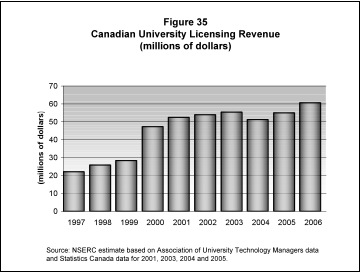
Figure 36
NSERC-Funded Innovations That Were Licensed
| What | Where | Who | Licensed to |
|---|---|---|---|
| A microrobotic technology for automated microinjection of zebrafish embryos. High-speed injection of zebrafish embryos is important for screening genes in genetics and drug molecules in drug discovery. | University of Toronto | Dr. Yu Sun | Marksman Celliject Inc. (Toronto, ON) |
| Dr. Finlay's research led to the development of Econiche, the world's first vaccine designed to reduce the shedding of E. coli O157:H7 by cattle. Most strains of E. coli are harmless but some, like O157:H7, can cause severe illness and even be fatal when ingested by humans. Vaccination of cattle with Econiche may help reduce the risk of food and water contamination by E. coli O157:H7. | University of British Columbia | Dr. Brett Finlay | Bioniche Life Sciences Inc. (Belleville, ON) The Canadian Food Inspection Agency licensed the vaccine for unrestricted use by Canadian cattle producers and their veterinarians. |
| Along with Dr. Malcolm Wilson, Dr. Tontiwachwithikul developed post-combustion, amine-scrubbing technology which uses an amine-based solvent to capture CO2 from flue gas after combustion. | University of Regina | Dr. Paitoon Tontiwachwithikul | HTC Purenergy (Regina, SK) |
| Along with graduate student Paul Kraeutner, Dr. Bird developed SARA-CAATI (Small Aperture Range Angle - Computed Angle-of-Arrival Transient Imaging.) Used on surface vessels, remotely operated vehicles or autonomous underwater vehicles, the SARA-CAATI system emits pulses, receives their echoes, processes the data and produces high resolution, 3-dimensional colour images of the seafloor. | Simon Fraser University | Dr. John Bird | Marport Canada Inc. (St. John's, NL) |
| Developed Organic Chemistry FlashwareTM, a multimedia tool intended to help students conceptualise chemical reactions at the molecular level. | University of New Brunswick | Dr. Ghislain Deslongchamps | Thomson Nelson (Scarborough, ON) |
Start-up companies established
Every two years, NSERC engages in a detailed study to uncover firms that were created based on university research. The start-up companies uncovered have all been founded on results of research funded partially by NSERC. The 154 start-up companies featured (see Figure 37 on the next page) are currently in the business of producing goods and services for Canadian and international markets. Combined, these companies employ nearly 19,000 Canadians and generate more than $3.9 billion in annual sales/revenue. Creating innovative goods and services using the latest technologies, these firms make an important contribution to Canada's economy. In addition to the 154 firms, there are 77 early stage spin-offs with the potential for future growth.
Active NSERC spin-off companies: 154
Early-stage NSERC spin-offs: 77
Acquired NSERC spin-offs: 32
TOTAL: 263
Employees (active companies): 18,922
Annual Revenues: $3.9 Billion
As of July 2008, 29 of the 154 start-up companies examined are/were publicly-traded firms. Although the gyrations of the markets have been significant in recent years, the market capitalization of these 29 publicly-traded firms on July 11, 2008 was an impressive $11.9 billion (see Figure 38). In addition to the direct economic benefits of contributing to Canadian GDP and employment, longer-term potential benefits of these start-up companies also exist. One already mentioned is the nearly 850 U.S. patents issued to the start-up companies over the past 10 years. Another secondary benefit has been the growth of major R&D firms in the country. In 2007, five of the top 100 Canadian R&D companies (as ranked by Research Infosource, 2007) were NSERC-related start-up companies with a combined R&D expenditure of $243M (see Figure 39). These results are important as Canada strives to increase R&D spending by Canadian firms.
Economic Analysis
The highlights of a recent economic analysis of NSERC-funded start-up firms conducted by Torben Drewes, a professor of economics at Trent University, are shown below.
Determining the exact return on investment (ROI) for NSERC investments in technology start-ups is a challenging problem. Structural models are required to capture the impacts of technology transfer, enterprise survivor rates, and productivity effects of R & D activities within the start-ups. The ROI estimates produced should only be taken as broad indicators.
Nevertheless, these estimates should produce a reasonable level of confidence that NSERC's investments in new technology-based enterprises have resulted in very significant returns in the form of new economic activity. All assumptions have been made to result in a conservative bias. Assuming the combined output of the 154 enterprises used in the estimates remain stable or alternately increase by 10% per year and the degree of incrementality assigned to NSERC is only 10 percent, results in ROI figures of 2.6% or 12.9%. These ROI numbers are calculated against the total of NSERC expenditures over the past 30 years.
The conclusion must be that the sizeable investment of taxpayer funds used to convert knowledge into economic value through the development of start-ups is producing considerable value for Canadians.
Figure 37: Companies Linked to NSERC-Funded Research, 1954 to 2007
(Number of employees in Canada in 2007)
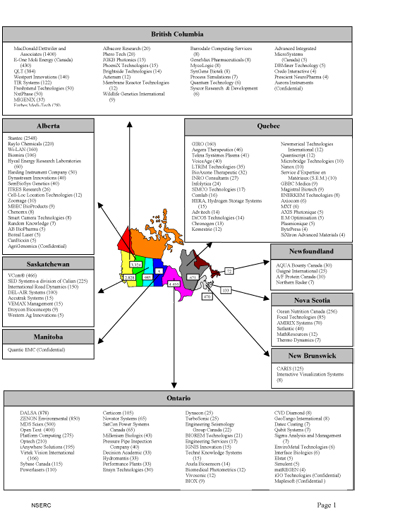
Figure 38
Market Capitalization of Start-up Companies
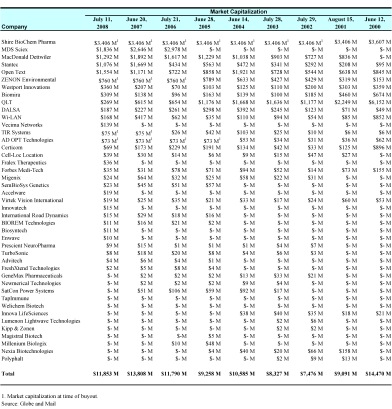
Figure 39
R&D Spending of Top Start-Up Companies Linked to NSERC
| NSERC Funded Start-Up Company | Rank | R&D Expenditure (millions of dollars) |
| Open Text Corporation | 37 | $67.1 |
| QLT Inc. | 38 | $64.0 |
| MacDonald Dettwiler & Associates | 54 | $44.5 |
| DALSA Corporation | 58 | $41.9 |
| Westport Innovations | 74 | $25.6 |
| Source: Research Infosource, Canada's Top 100 Corporate R&D Spenders List 2007 | ||
New and improved products and processes introduced to market
NSERC-funded researchers have created or developed many new products and processes, the value of which is difficult to estimate. Respondents to NSERC's 2007 researcher survey, previously mentioned, indicated significant involvement in the development of new goods or services (see Figure 40). Also as part of a past evaluation of NSERC's largest program, the Discovery Grants program, over 20% of the 3,032 respondents who held a grant indicated a major contribution to the development of new or improved products or processes. By way of example, Figures 41 to 44 list a sample of some of the new products or processes developed by NSERC-funded professors in the information technology, energy, environment, and health sectors, respectively.
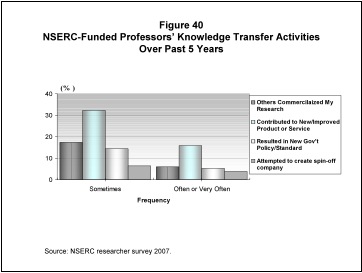
Figure 41
Information Technology Innovations Funded by NSERC
| What | Where | Who | Why |
|---|---|---|---|
| Prototype for new magnet | University of Victoria | Dr. Robin Hicks | Developed a prototype for magnetic materials that could be used to make extremely thin magnetic computer memory and ultralight spacecraft parts. |
| Developed music composition software | University of Western Ontario | Dr. Mike Katchabaw | Dr. Katchabaw's team developed the Algorithmic Music Evolution engine, AMEE. The program allows users to import their own musical creations and even control the emotional content of the music. The researchers will further develop AMEE and present it to companies needing music for everything from cell phones to computer games. |
| Eyebox2TM | Queen's University | Dr. Roel Vertegaal | Eyebox monitors eye movements in real time from up to 10 metres away so advertisers can track how many people look at their billboards and screens. |
| Wireless biosensors | Simon Fraser University | Dr. Bozena Kaminska | Dr. Kaminska developed disposable, wearable, wireless biosensors to be used as diagnostic and monitoring tools. The biosensors incorporate mixed-technology electronics developed in Kaminska's CiBER lab. CiBER is working with Nokia to develop a system for transmitting the data to cell phones that would send warning and emergency messages to care providers. |
| Developed software to catch cheaters | McMaster University | Dr. George Wesolowsky | Dr. Wesolowsky developed a software program designed to disclose who has cheated on a test. The program, called Scheck, uses statistical methods to detect cheating on multiple choice tests by looking at the patterns of people's answers. |
| Invented a device that generates power while you walk | Simon Fraser University | Dr. Max Donelan | Donelan's team created a device that generates enough power to run 10 cell phones or a couple of small computers - while you walk. |
| First execution of a quantum calculation | University of Toronto | Dr. Daniel James | Dr. James was part of the international team that made the calculation. The calculation represents a major step towards building the first quantum computers. |
Figure 42
Energy Technology Innovations Funded by NSERC
| What | Where | Who | Why |
|---|---|---|---|
| A solar hot-water heating system | Queen's University | Dr. Stephen Harrison | Dr. Harrison developed a solar panel with a mechanism that prevents overheating. He also created a passive back-flushing thermal system. Both inventions are part of a hot water system sold in North America by EnerWorks. |
| Created a better solar cell | Universit� de Qu�bec � Montr�al | Dr. Beno�t Marsan | The new solar cell is flexible, inexpensive to manufacture, transparent and very versatile. While the idea is not new, the process and materials used are innovative. Marsan's team hopes to bring the cell to market within the next three years - not just for use in buildings, but also in cars, and maybe even on clothing. |
| Superconductor breakthrough | University of Sherbrooke and University of British Columbia | Dr. Louis Taillefer, Dr. Nicolas Doiron-Leyraud and Dr. Douglas Bonn | Using uniquely pure crystals, the research team detected an elusive signature of electrons within a high-temperature superconductor. One of the most promising applications for the discovery is in magnetic levitation trains. The force of powerful magnets suspends the trains in the air above the rails, eliminating friction from moving parts. |
| Storing hydrogen safely | University of Windsor | Dr. David Antonelli | Dr. Antonelli discovered that using silica (a component found in glass) and titanium oxide helps store large quantities of hydrogen safely. |
| Discovered a new superconductor | University of Montreal | Dr. Andrea Bianchi | Dr. Bianchi headed the team that found the new superconductor - made of cobalt, indium and a rare earth that lets electricity flow freely, without loss of energy, when cooled to just a few degrees above absolute zero. |
| New way to trap gases in molecule-sized tanks | University of Calgary | Dr. George Shimizu | At the moment, gas storage can pose safety risks as it needs to be kept at very high pressures. The research team developed a crystal structure that can store gas molecules indefinitely without the need for pressure. They use 'molecular nanovalves' - and the system has the added bonus that gas can also be released easily. |
Figure 43
Environment Innovations Funded by NSERC
| What | Where | Who | Why |
|---|---|---|---|
| Wind tracking radar | University of Western Ontario | Dr. Wayne Hocking | Dr. Hocking leads an Ontario-Quebec research team that uses a specialized radar to track wind speed and directions. The team's first findings have shown large streams of ozone leaking from the stratosphere to almost ground level where it transforms into smog. |
| Fish harmed by common chemical | Mount Allison University | Dr. Suzanne Currie | Dr. Currie found that 4-nonylphenol (4-NP) disrupts the sense of smell in fish leading them to avoid each other instead of gathering in schools. The chemical is found in industrial detergents, sewage treatment and agricultural pesticides. |
| New technique to measure greenhouse gases | Carleton University | Dr. Matthew Johnson | This patented technique uses mathematical models and instruments to measure methane leaks in pipeline and gas flares at oil wells. The team discovered that emissions from gas flares and venting have been reduced by 42 per cent from 2002 to 2005. |
| Developed safe "green" decontamination method for chemical warfare agents and pesticides | Queen's University | Dr. Stan Brown | Brown's team found a new method for rapidly and safely destroying toxic agents such as chemical weapons and pesticides. |
| Found new evidence drugs getting into drinking water | University of Waterloo | Dr. Mark Servos | Servos' team found painkillers such as ibuprofen, cholesterol-lowering drugs and the common household antibacterial agent triclosan in treated drinking water from 15 plants in the Burlington, Ontario region. Amounts are tiny, but researchers don't know the human health effects of long-term exposure, even to small amounts. |
Figure 44
Health Innovations Funded by NSERC
| What | Where | Who | Why |
|---|---|---|---|
| A new and improved hearing aid | McMaster University | Dr. Suzanna Becker and Dr. Ian Bruce | Invented the NeuroCompensator, a chip which trains hearing aids to hear sounds that damaged parts of the ear can't pick up. The patented technology has attracted interest from Cayce Medical. |
| Improved design of nano-scale sieve | University of Alberta | Dr. Jed Harrison | Along with graduate student Yong Zeng, Dr. Harrison improved upon an older model of molecular sieve. The new sieves cost much less to make and can be re-used 10 times. The sieve has potential applications in biomedical research - allowing researchers to separate viruses from fluid or tissue samples. |
| New device to detect scrapie | University of Guelph | Dr. Gordon Hayward and Dr. Warren Stiver | Created a new device that identifies prions, the root of scrapie, a fatal degenerative disease that affects the nervous systems of sheep. The researchers say the instrument could also be used for other degenerative diseases in the same family as scrapie, such as bovine spongiform encephalopathy, BSE, in cattle, and Creutzfeldt-Jakob disease in humans. |
| Technique to diagnose asthma in children | Dalhousie University | Dr. Geoffrey Maksym | Developed a more sensitive and reliable asthma diagnostic technique that measures the spasm in the smooth muscle which lines the airways. |
| Laser-enhanced microscope allows better views of cells | Queen's University | Dr. Albert Stolow and Adrian Pegoraro | Developed a technique involving a laser and microscope in order to view cell parts without using traditional dyes which can be toxic and alter the cellular environment. |
| Armrest that reduces repetitive strain injuries | University of Guelph | Dr. Michele Oliver | The armrest works by reducing muscle activities in the neck which helps prevent repetitive strain injuries. The device was originally designed for machinery operators, but can be used on any chair. |
| Playbot, a child's robotic wheelchair | York University | Dr. John Tsotsos | Created a motorized robotic wheelchair for children. The chair has a robotic arm, a camera and a communications panel. |
2.3.2 Support Commercialization
An overview of the "support commercialization" program activity is presented below:
| Description | Expected Results | ||
| This program activity supports innovation and promotes the transfer of knowledge and technology to Canadian companies by supporting technology transfer activities at Canadian universities. | The transfer of knowledge and technology from Canadian universities and colleges to the user sector is facilitated. | ||
| Resources (2007-08) | Clients Supported (2007-08) | ||
| Planned Spending | $15.2M | Professors | 105 |
| Actual Spending | $10.7M | Undergraduate Students | 28 |
| Planned Human Resources | 6 | Master's/Doctoral Students | 42 |
| Actual Human Resources | 12 | Postdoctoral Fellows | 15 |
The key programs under this program activity are:
- Intellectual Property Mobilization (IPM) Program ($3.6M): Developed by NSERC in 1995, this program is now funded by NSERC, SSHRC and CIHR. The objective of this program is to accelerate the transfer of knowledge and technology residing in Canadian universities and hospitals for the benefit of Canada. The IPM program provides funding in partnership with universities and hospitals to support activities related to managing and transferring intellectual property resulting from publicly funded research performed at universities.
- Idea to Innovation (I2I) Program ($5.5M): I2I accelerates the pre-competitive development of promising technologies and promotes its transfer to Canadian companies. The program supports R&D projects with recognized technology- transfer potential by providing crucial assistance to university researchers in the early stages of technology validation and market connection.
Funding for the College and Community Innovation Program ($0.3M) and for the administration of the above programs rounds out the spending under this program activity.
As presented in Figure 32, university technology transfer offices are handling an ever-increasing load of intellectual property management.
In 2007-08 an evaluation of the IPM program was conducted, with the key findings summarized below:
- IPM has assisted institutions to develop the skills of university staff by providing funding for professional development initiatives. The most significant initiative has been regional internship training programs, which offer the following benefits: a relatively standardized approach to developing interns into technology transfer professionals; an effective mechanism for attracting qualified candidates; and a way to reduce hiring risks by allowing them to evaluate the potential of a candidate over many months at low cost, without the obligation to hire them.
- Evidence gathered by the evaluation, in conjunction with data from Statistics Canada (see Figure 32), confirms that the rate at which technology is being transferred from universities and hospitals has increased dramatically in the last decade.
The Idea to Innovation program has been active since 2003. The program attracts between 80-120 Phase I proposals each year, while fewer Phase II proposals are received (6-12 per year).
As part of the program management, NSERC receives annual reports on the progress in the projects. A recent study by NSERC staff followed up on Phase I proposals that were funded, to better understand the issues leading to the low level of follow-on Phase II projects. This study of 74 grants identified that:
- 19% of the phase I projects were moving to Phase II
- 15% of the Phase I projects demonstrated that the technology was not feasible,
- For 8% of the grants, the technology was transferred without the need for further funding
- 30% of the teams were working with the partner to transfer the technology
- 26% of the projects were looking for a partner.
